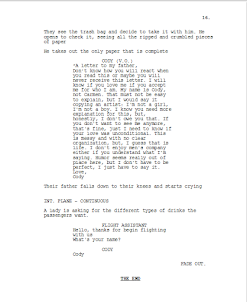Marking the start of a long thought process such as
the creation of a creative piece is usually become meddled up in my brain, with
lines of thought coming and going, no clear path to where they start or finish.
What has worked best in the past to narrow down my constant brainstorming is to
put ideas on paper and see if they continue to excite me. But, I have two more organized
ways of choosing, one that I learned during the summer and a new one more
recently
The one that I learned first goes as follows:
Step 1: Come up with 5 ideas
This exercise leads my mind wonder around different
ideas, but still having more of a structure that simply writing them down. It
details to have a short synopsis, describe the protagonist’s goal and the
antagonist, the force between the protagonist and its goal. These ideas had to
be able to be seen as shorts as well, so many long term stories that I may have
had were discarded firsthand, helping me adapt and coming up with stories that
will fit into these parameters.
Step 2: Writing a logline, a sentence for beginning,
middle and end, expand from those
While it may see counterproductive to write a one or
two-sentence description of your initial idea, it can help to come to what the
core of the story is about, as well as noting what is the most important aspect
of it. Then, by doing a simple description of each step of the three-act
structure, serves the same motive, expanding from it and explaining why each
choice is necessary and serves a purpose for the stories’ development and characters.
It can help to see, for the future screenwriting, how the story may move and
act accordingly to this pace.
Step 3: Answer questions as your protagonists
It is a very cathartic experience to answer questions
as your character, similar to a character sheet, but more personal. While of
these details will probably not end up playing an important role in a short
story, it is interesting to bring the character more depth and understand how
they would react to the situations that they are being put in. The Basics may
seen to include information that is not relevant in a normal day, but you can
decide which will or not, having to separate yourself from your character,
deciding how similar or not to you they are.
Step 4: Beat Sheet and Structure:
Similar to earlier steps, it is the closest it will
come into actually writing the first draft, with all of the events neatly organized
and classified into their respective acts. It is the simple events, not much
with detail. You can choose what to include or not, helpful for those who tend
to get writer’s block and do not how to continue, outlining it first.
From this point, the story can write itself, not
literally, but only had to be formatted into the chosen form. While this
structure has helped me in the past, the other new type of creating this film,
without much strict parameters, less tedious and helpful if you are lacking ideas
is:
Step 1: Theme
From the preexisting themes, it is easier to see how
many stories develop from these, even though it may appear they are original. It
is not to copy themes, it is to get one and be able to see how they are in the
story overall. Can be more than one, to help idea how they interrelate.
Step 2: Premise
It is the moral or the advice that you want the
audience to take after they finish with the story. It can help to start to
envision how you would want to portray your theme, with the different technical
elements. Many themes go well with a certain premise, but a unique combinations
of them can help to adapt and become more creative.
Step 3: Characters
By creating the characters to fit into the main story,
not vice versa, helps to see which types of individuals or creatures are able
to personify the idea. As well as creating form archetypes, helping bring more plots
into the story.
Step 4: The Genre
The genre of each film comes with certain codes and
conventions, the ideas and images that make people be able to identify the
genre easily. It groups similar films together, but can help focus in which
direction you would take the story a premise of “life not fair” in a comedy
would develop and feel different than the same premise in the drama genre.
While continuing form the main idea you have to create
a short film would still need more development than this. By analyzing and listing
the different methods, I will probably use a combination of the two, using the
last described as the beginning of the process and the first as getting ready
to jump into scriptwriting. At the moment, I have ideas already develop, having
two, with a few changes, from my initial brainstorming. With the following
post, I hope to be able to have a definite answer.
Citations:
Gregory, D.W. “99 Questions to Ask Your Character - Dramatics Magazine.” Dramatics Magazine Online, 17 Apr. 2019, dramatics.org/99-questions-to-ask-your-character/.
Jordan, et al. “How to Choose Good Themes for Stories: 5 Tips.” Now Novel, 15 May 2017, www.nownovel.com/blog/choosing-themes-for-stories/.
















